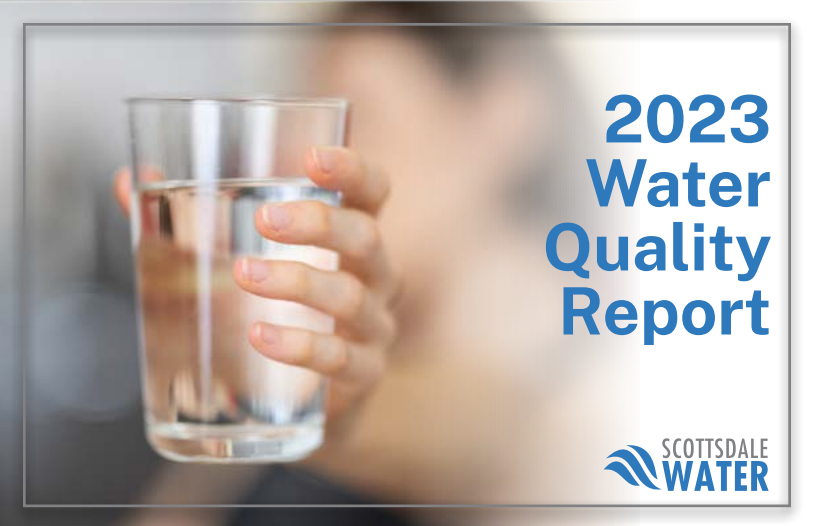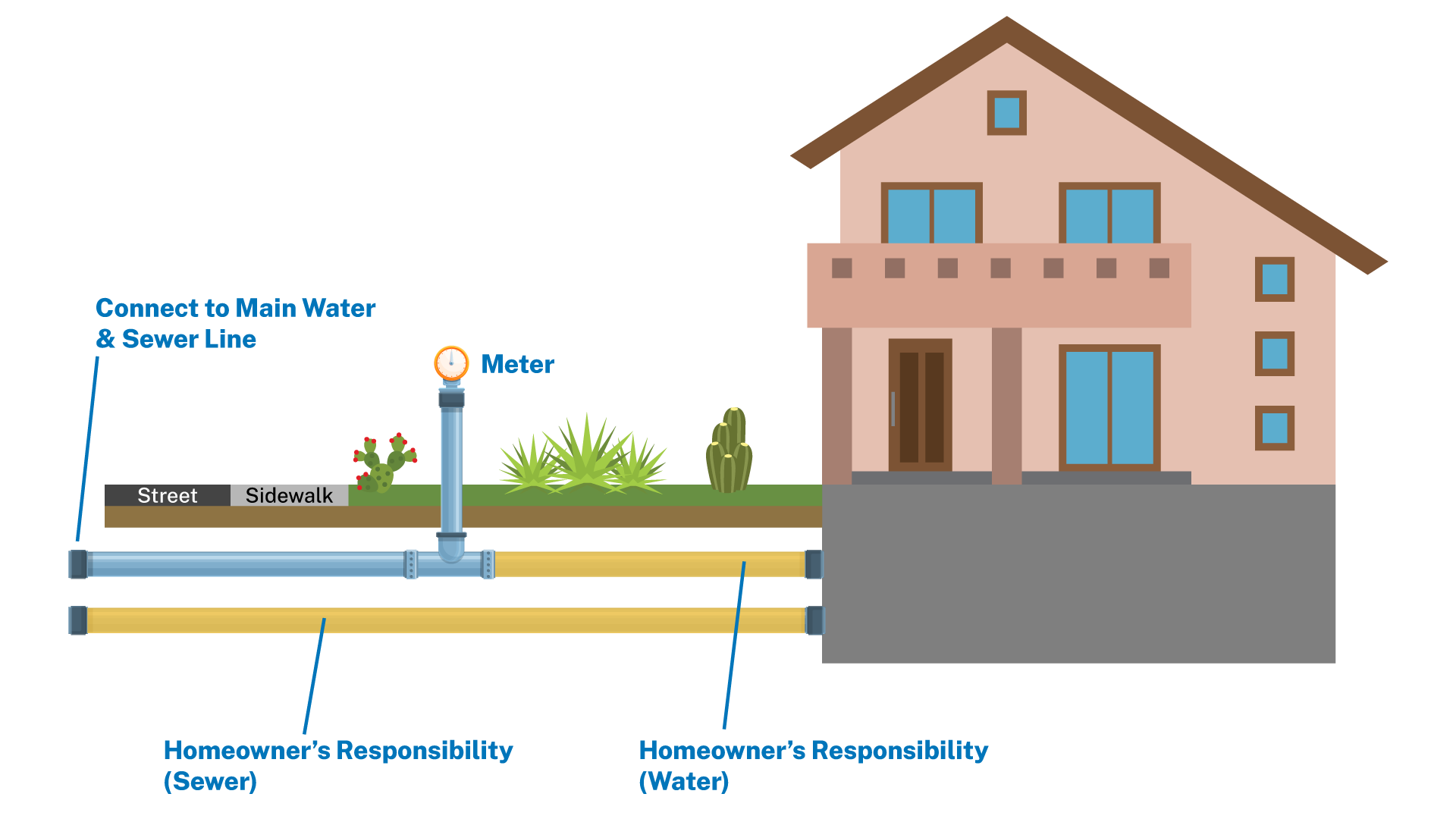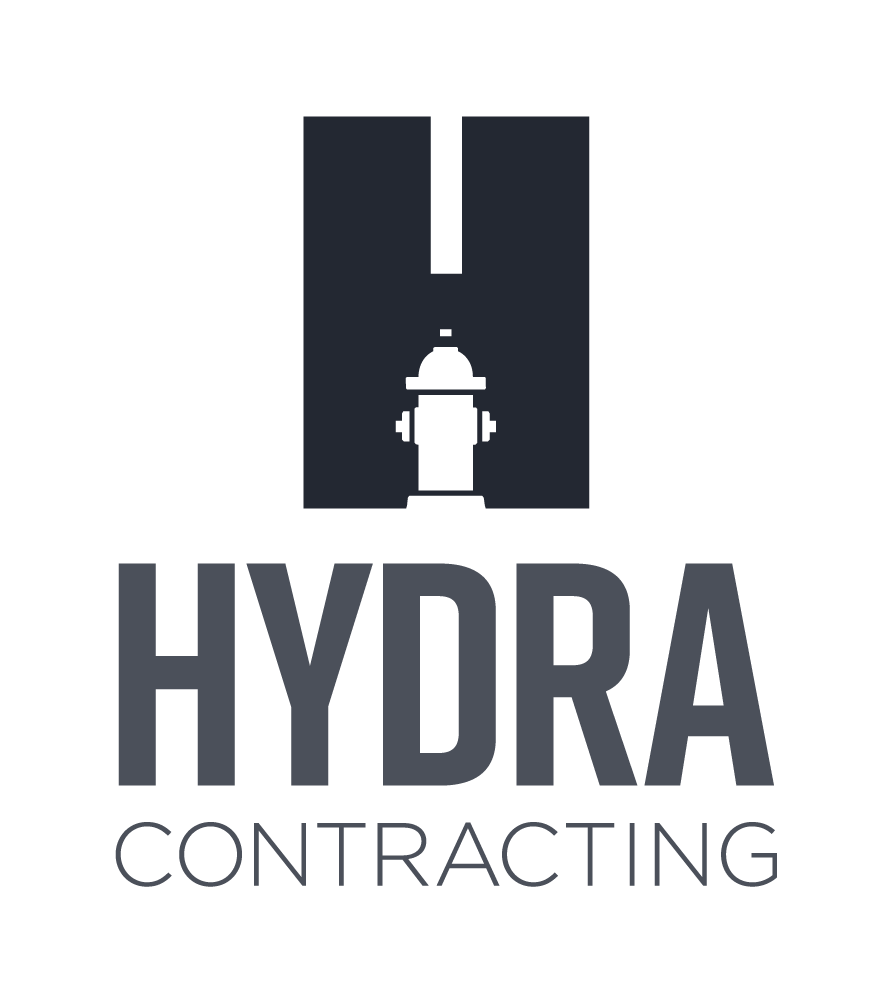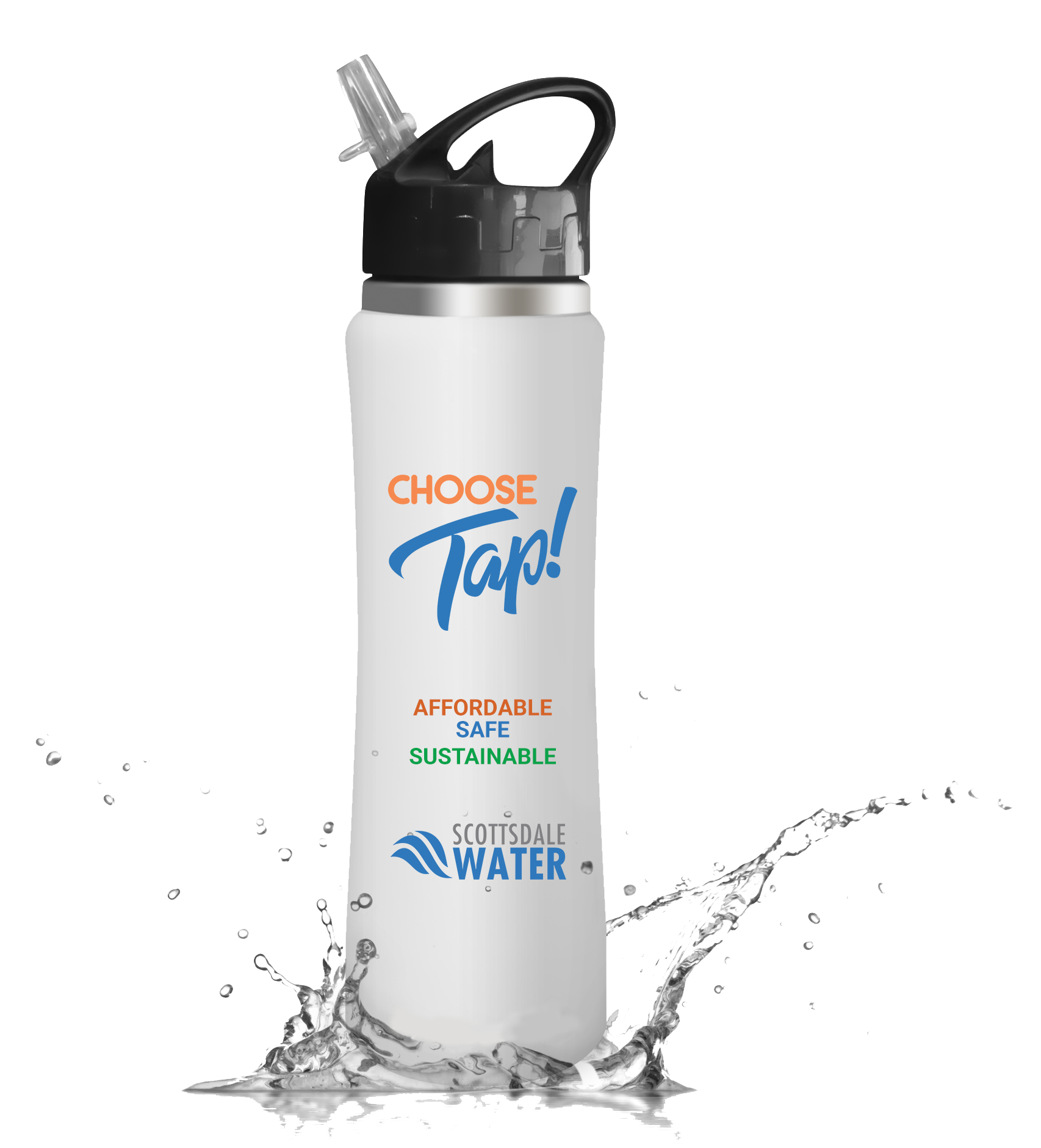Drinking Water
Your Drinking Water
Scottsdale Water is committed to providing the highest quality water and service to our customers. We perform hundreds of tests on a regular basis to ensure the water you are drinking meets or surpasses the standards set by the Environmental Protection Agency. We work closely with the EPA, state and county officials to make certain all drinking water standards are met every time you open a tap at your home or business.
Scottsdale uses some of the most technical and advanced water treatment processes available to provide you with the best drinking water available. While the treatment and disinfection process reduces the number of impurities found in your drinking water, there are still traces of minerals and other chemicals in the water you use every day.
Water Quality Reports
Scottsdale Water annually publishes the Water Quality Report – a comprehensive compilation of valuable information regarding your drinking water, including where your water comes from, water treatment processes, the many results from continuous testing and how we stack up to federal standards. Download a PDF version from the links below:

- 2023 Water Quality Report
- 2022 Water Quality Report
- 2021 Water Quality Report
- 2020 Water Quality Report
- 2019 Water Quality Report
- 2018 Water Quality Report
- 2017 Water Quality Report
- 2016 Water Quality Report
- 2015 Water Quality Report
- 2014 Water Quality Report
- 2013 Water Quality Report
- 2012 Water Quality Report
- 2011 Water Quality Report
Common Drinking Water Questions
Scottsdale does not add fluoride to our drinking water but Scottsdale water sources contain low levels of naturally occurring fluoride ranging from 0.3 to 1.0 ppm.
Download a fact sheet about about hard water
Water hardness is a result of naturally occurring calcium and magnesium dissolved in water. As surface water makes its way to our treatment plants and groundwater flows through the aquifer, it picks up high concentrations of these minerals, making the water “hard.”
Hardness is not a primary water quality standard. It may present aesthetic concerns, but it is not considered to be a health risk. Scottsdale Water is committed to providing our customers the cleanest and safest drinking water possible, at an affordable price. We could implement additional treatment processes to address hardness, but these processes are not cost effective, especially considering about 70 percent of residential water consumption is used outdoors.
There are varying levels of water hardness in Scottsdale. Approximates hardness levels are shown in the table below.
| Boundary | Hardness (Grains per Gallon) | Hardness (mg/L or ppm) |
|---|---|---|
| South of Indian School Road | 22 - 25 | 370 - 430 |
| Indian School Road to Chaparral Road | 20 - 22 | 340 - 370 |
| North of Chaparral Road | 16 - 18 | 275 - 300 |
The city is required by federal and state drinking water regulation to disinfect water before it enters the distribution system in order to control potentially harmful microbial activity in the water. Scottsdale, like most municipalities uses chlorine for disinfection. Levels of chlorine are carefully controlled so that disinfection is effective, yet not overwhelming to the water customer. Unfortunately some people are more sensitive to chlorine than others and may find any level of chlorine displeasing.
Water will sometimes have a milky appearance due to entrapped air. If you fill a clear glass with the water and let it sit for two to three minutes the air bubbles will rise to the top and eventually disappear. The appearance of milky or cloudy water may also occur if two source waters of differing temperatures meet in the distribution system or inside your home’s plumbing.
This smell can develop in hot water heaters due to sulfates that are present in the water and their reaction to sulfate-reducing bacteria, which thrive in the warm temperatures of water heaters. The smell generally occurs when the temperature of the water heater is set low or the water is allowed to sit for days or weeks unused. To reduce the odor, you can try turning up the water heater to 140° to kill the bacteria or call a plumber and have the water heater drained and refilled.
The smell of sewer gas when you turn on the faucet is probably not from the tap water but rather from your drain. Sewer smells will occur if the U-shaped trap under your drain is not working properly, either from a leak or if the water in the trap evaporates. Drains also collect lots of bacteria and other matter that over time may emit unpleasant odors. To determine the source of the odor fill a clean glass from the affected faucet and then move to another room or go outside and smell the water. If the odor is detected in the water from the glass, please contact us for assistance. If the odor is not detected, the smell is probably coming from your drain and you may want to contact a plumber.
Arsenic is a mineral that naturally occurs in groundwater in many parts of the country, including the Southwest. In 2006, the EPA lowered the maximum level for arsenic from 50 parts per billion (ppb) to 10 ppb. Scottsdale invested approximately $100 million in facilities to ensure compliance with the EPA standards for arsenic and has committed to a more stringent standard not to exceed 80 percent of the EPA’s standard.
The level of arsenic in Scottsdale’s water varies depending on the source of the water. In 2015, the average arsenic level detected in Scottsdale’s drinking water was 4.7 ppb, while the highest single level detected was 6.4 ppb.
The EPA has addressed the risk from Hexavalent Chromium by setting a maximum contaminant level (MCL) for Total Chromium at 100 parts per billion (ppb). In 2016, Scottsdale’s average Total Chromium level was 7.5 ppb for our source water, which is well under the EPA-designated MCL. The annual average in our distribution system, which represents what is received by our customers, is 1.3 ppb. Scottsdale water relies heavily on our surface water sources, which have very low concentrations of Hexavalent Chromium. Our groundwater wells are generally used to meet demand during summer peaking only.
Lead and copper are typically found in drinking water because of materials and components found in service lines and home plumbing. If present, elevated levels of lead can cause serious health problems, especially for pregnant women and young children. Scottsdale is committed to providing high quality drinking water, but cannot control the variety of materials used in plumbing components. When your water has been sitting for several hours, you can minimize the potential for lead exposure by flushing your tap for 30 seconds to 2 minutes before using water for drinking or cooking. If you are concerned about lead in your water, you may wish to have your water tested.
Information on lead in drinking water, testing methods and steps you can take to minimize exposure is available from the Safe Drinking Water Hotline (800-426-4791) or at epa.gov/safewater/lead.
In 2014, Scottsdale Water tested for lead and copper from water faucets inside 68 Scottsdale homes that were built before the lead ban. Results from all homes were below the action levels for lead and copper.
Drinking Water Quality Monitoring Program
Scottsdale water is extensively tested to ensure that it remains safe for consumption. The Safe Drinking Water Act sets various drinking water rules and regulations that water systems must comply with. The Environmental Protection Agency (EPA), Arizona Department of Environmental Quality (ADEQ) and Maricopa County work together to enforce drinking water regulations.
Scottsdale Water conducts routine monitoring at treatment facilities, well sites and in the distribution system. Additionally, when a new water source is brought into service, extensive testing is done to ensure it meets guidelines established by EPA.
Routine Monitoring
Turbidity is a measure of water’s clarity, which is improved through the water treatment process. Turbidity is caused by suspended matter such as organic and inorganic particulates, silt, algae or tiny microorganisms. Water that is highly turbid is more likely to contain undesirable microbial contamination. To ensure that safe turbidity levels are achieved and maintained, turbidity is measured continuously at our surface water treatment facilities.
Chlorine is used as a disinfectant to ensure the destruction of potentially harmful microbes and to control microbial activity within our distribution pipes. Chlorine levels are monitored continuously at our water treatment plants and at over 150 sampling stations throughout the distribution system to ensure that safe, adequate levels are maintained. Scottsdale’s goal is to have a chlorine residual between 0.8 and 1.2 parts per million (ppm) in water distributed to customers.
Every month the Scottsdale Water tests over 150 sites within the distribution system for Total Coliform and E.Coli bacteria in order to ensure that microbial contamination has not occurred. Total Coliform bacteria are considered a useful indicator of microbial contamination because these bacteria are impacted by water treatment and disinfection in a manner similar to most bacterial pathogens and many viral enteric pathogens. Total Coliforms are used to determine the adequacy of water treatment and integrity of the distribution system.
On a quarterly basis, levels of disinfection byproducts (DBPs) are measured within the distribution system at various sites throughout the city. Disinfection byproducts are formed as a result of a chemical reaction between chlorine and naturally occurring organic matter in the water. In order to minimize the formation of disinfection byproducts, levels of Total Organic Carbon (TOC) are reduced through the treatment process primarily through the use of granular activated carbon (GAC) adsorption. TOC levels are monitored before and after water treatment to ensure adequate removal of TOC. Further, chlorine levels are carefully controlled so that disinfection is effective while minimizing levels of disinfection byproducts.
Nitrate is measured annually at all groundwater sources and at least quarterly at our surface water treatment plants. For groundwater sources that have nitrate levels greater than 5 ppm, testing is performed quarterly.
Groundwater in Scottsdale and throughout Arizona contains naturally occurring arsenic. Arsenic is also present in surface water originating from the Verde River watershed. Scottsdale operates three arsenic treatment facilities that remove arsenic from groundwater. The Chaparral Water Treatment Plant also has arsenic treatment capabilities for water received from the Verde River (via Salt River Project). The water treated at these facilities is monitored weekly or more frequently to ensure that arsenic levels do not exceed the regulatory limit of 10 parts per billion (ppb).
Other inorganic contaminants, including but not limited to fluoride, chromium, barium, thallium and mercury are measured at each water source on an annual basis.
Organic contaminants including herbicides and pesticides are measured every three years at each water source, Volatile Organic Compounds (VOCs) such as gasoline derivatives and solvents are measured annually or more frequently. If a regulated organic compound is detected in our drinking water, federal regulations require quarterly monitoring of that contaminant in order to make certain that the concentration does not rise to unsafe levels.
Radiochemical contaminants including gross alpha emitters and uranium are measured quarterly when a new water source is brought into service. Once baseline levels are established, monitoring is performed every three, six or nine years depending on the water source. Most Scottsdale water sources require monitoring every six years.
Cryptosporidium is a microbial pathogen found in surface water throughout the United States. Ingestion of Cryptosporidium may cause cryptosporidiosis, a gastrointestinal illness. Cryptosporidium must be ingested to cause this illness, and it may be spread through means other than drinking water. As required by federal regulation, Scottsdale’s source water has been extensively monitored for Cryptosporidium to ensure that our current treatment technologies are sufficient to remove this pathogen. The city continues to conduct voluntary monitoring for Cryptosporidium in our source water.
The primary source of lead and copper in drinking water is not the source water, but rather household plumbing fixtures and pipes. Lead and copper may leach from faucets or plumbing components into water when the water stands motionless for several hours. Leaching may also occur in copper pipes joined with lead-based solder. Because the water in your pipes can pick up these metals, installation of lead-containing solder, pipes, and fittings was banned in 1986. Lead and copper testing is performed in 50 Scottsdale residences every three years. Residences that participate in this monitoring program are selected based on criteria established in the Lead and Copper Rule.
Water Quality Laboratory
Scottsdale’s Water Quality Laboratory, located at the Water Campus, is one of the most advanced municipal water quality laboratories in Arizona. Its main goal is to ensure the water delivered to Scottsdale Water customers meets or exceeds the requirements of all local, state and federal drinking water standards. The laboratory also tests for numerous unregulated contaminants in an effort to remain at the leading edge of future regulations and technologies.
In addition to finished drinking water, the lab also analyzes industrial discharge into the city’s sewer system, recycled water, nonpotable groundwater wells and drinking water supply sources (CAP and SRP canal water).
The Scottsdale Water Quality Laboratory is certified by the Arizona Department of Health Services, which entails thorough audit of procedures and data quality on a biannual basis.
Chemical Contaminants
The lab analyzes for chemical parameters in four specialty areas:
- Metals: Trace metals such as arsenic, sodium, lead and copper are analyzed for using an Inductively Coupled Plasma Mass Spectrometer;
- Inorganic compounds: Nitrate, chloride, total organic carbon, and pH are few of the nutrients and physical parameters analyzed for in the Wet Chemistry laboratory;
- Organic compounds: Compounds such as toluene, MTBE and TCE are analyzed for using Gas Chromatographs;
- Semi-volatile organic compounds: Compounds of potential concern, such as pharmaceuticals, pesticides, and flame retardants are looked for using a Gas Chromatograph and the very precise Liquid Chromatograph Mass Spectrometer/Mass Spectrometer.
Microbiological Contaminants
The microbiology laboratory focuses on organisms such as coliform bacteria and is one of the few municipal laboratories certified by the EPA for Giardia and Cryptosporidium analysis. The lab utilizes both basic metabolic identification and molecular detection techniques for rapid identification.
Lead Testing in Schools
As part of the Arizona Department of Environmental Quality’s proactive statewide public school drinking water lead screening program, Scottsdale Water tested representative drinking water sources at all public schools in the Scottsdale Water service area in 2017. The testing has also been offered at no charge to all private and charter schools and daycares. View a list of schools that have been screened. (PDF)
Environmental Protection Agency (EPA) Lead and Copper Rules Revisions
The Environmental Protection Agency (EPA) finalized the Lead and Copper Rules Revisions (LCRR) with an effective date of December 16th, 2021. Scottsdale Water has been in compliance with the original Lead and Copper Rule (LCR) since 1991 and will continue to work with the Arizona Department of Environmental Quality to implement the new requirements of the LCRR. The LCRR requires all community water systems to complete a material inventory of all public (city owned) and private (customer owned) service lines no later than October 16, 2024. This will be the first time the city is required to identify the material for the entire length of the service line to a customer’s home.
Background
Sources of lead are not typically found in groundwater or surface water supplies. Sources of lead in water are most often from household plumbing fixtures/pipes or service lines. The use of lead in pipes and plumbing materials was banned in the 1986 Safe Drinking Water Amendments with an effective date of June 1988. Therefore, homes built after 1989 should not have plumbing materials containing lead. The LCRR requires all lead and galvanized service lines to be identified in the inventory. Scottsdale has been actively removing public galvanized lines for several years.
Goal
The goal is to complete the EPA required inventory of all service lines by the compliance date of October 16, 2024, and identify any public and private service lines that could be possible sources of lead. Scottsdale Water does not anticipate finding any lead service lines and will continue the removal of all public galvanized lines.
Process
Scottsdale Water is working with a contractor to identify the material of public and private service lines installed prior to 1989. There are over 45,000 service lines that will need to be surveyed over the next two and half years. The contractor will make visual observations on both sides of the water meter and at the line entering the home located at the hose bib attached to the house as shown in figure below. Scottsdale Water will work with the contractor to prioritize homes with a higher risk of possible lead sources. If you have concerns about lead in your home, please contact 480-312-8732 or [email protected].

There are only a few options available to perform this inventory and the decision was made by the City to use the least disruptive method. Scottsdale has hired contractors, Hydra Contractor and MSI (badge logos shown below), to document and photograph the visible pipe materials on both sides of the water meter and at the hose bib at individual homes. The photographs are necessary to prove inventory performance. The inventory must be complete and submitted to the Arizona Department of Environmental Quality no later than October 2024.


City contractors wear badges with their company's logo.
To check the legitimacy of a contactor, please call Customer Service at 480-312-5650.
Results
All results will be made available to the public once the inventory is complete. More information can be found at epa.gov/lead
Contact Information
Scottsdale Water Resources
9312 N 94th St
Scottsdale, AZ 85258
P: 480-312-5650
Office Hours
Monday through Friday
7 a.m. to 4:30 p.m.


